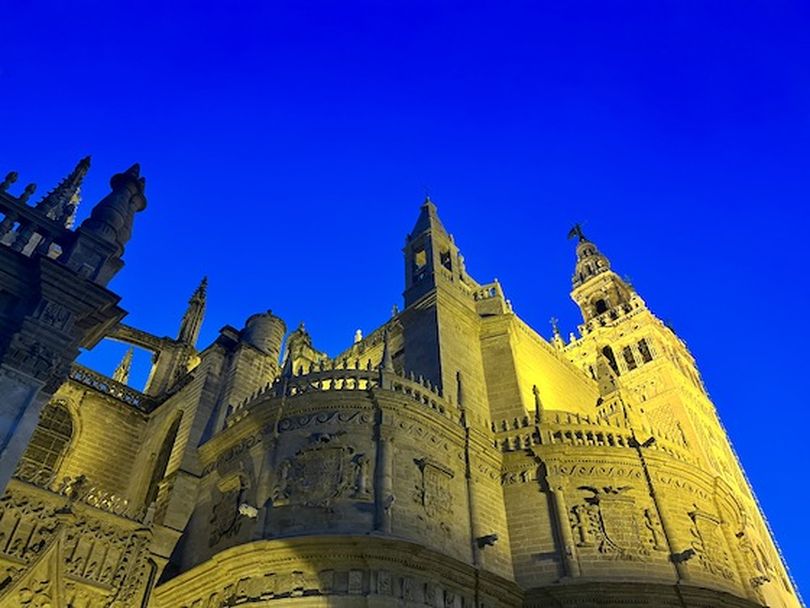Sevilla is a blend of Spain’s past, present

Just to be clear, for the past few blog posts I’ve been writing about the recent trip that my wife, Mary Pat Treuthart, and I took through Spain and Portugal. In the most recent post, I described our last day and night in the Costa del Sol beach town of Nerja.
I should add that when we told local people in the other cities that we’d visited – Madrid, Córdoba and Granada – that we were headed to Nerja, they all said pretty much the same thing: We know all about Nerja. Everyone in Spain does.
Turns out, a massively popular television show from the ’80s titled “Verano Azul” – or “Blue Summer” – was filmed there. And, apparently, a park devoted to the series still exists in the town – though I’ll admit we didn’t get around to visiting it.
Why was the series so popular? Well, for one thing, the area itself is so scenic. More important, however, Spain in the 1980s was far different from when the former dictator Francisco Franco was alive. He died in 1975, as a skit from “Saturday Night Live” around that time continually reminded us. And “Verano Azul” was a fresh change to the conservative feel of Franco’s era.
As one description of the show on IMDb.com explains, “Throughout the 19 episodes, several key themes are dealt with: adolescence, coming of age, death, the generation gap, the right to protest, ethical values, family relationships, and even building companies' speculation in the Spanish coastline.”
Anyway, we said goodbye to Nerja and made the three-hour drive to the car-rental facility at the airport in Sevilla. And as a side note, we had to pay 50 euros to fill up our MG, which equates to about $56. And that was just for half a tank. Gas in Europe is far more expensive than even the high prices we’ve been paying in the U.S. over the past few years.
We dropped off the car and took a taxi into the city. Our destination: Hotel Casa 1800, which sits in Sevilla’s historic center and whose claim to fame – besides its sitting in the shadow of the city’s famous cathedral – is that it once was one of Sevilla’s mansion-palaces of the early 19th century.
I’ve already written about our stay in Sevilla, particularly about Mary Pat’s ingenious plan that got us into the Catedral de Sevilla, despite its being sold out, by signing up for a French-language tour. And this despite the fact that neither of us speaks much more than restaurant French. So, I won’t repeat myself.
Though our hotel tried to help us gets cathedral tickets, but couldn’t, he did get us entry the following day to the Real Alcázar de Sevilla, a royal palace – I learn later – that was built on the site of a Muslim fortress that was destroyed during the Christian conquest of the city in 1248. Since it was then still early enough in the afternoon, we decided to take a walk through the neighborhood – which is when we spotted an advertisement for the local Hop-on Hop-off Bus Tour.
We’ve taken advantage of similar tours in cities as diverse as Dublin, Auckland and Cape Town. So, we figured that it would give us a feel for Sevilla that we probably wouldn’t get to experience otherwise. Seated on the top level of the double-decker bus, we toured both sides of the Guadalquivir River, famous for being Spain’s only navigable river and where Magellan started his 1519 trip around the world.
We didn’t get off, although that is one of the benefits of the tour (there’s a reason it’s called Hop-on Hop-off). But we took notes to see if we might want to check things out the next day. And anyway, we did get to see a number of the city’s sites, from the various plazas and varied examples of architecture to the area called Triana, which is said to be the center of the city’s ceramics industry.
Then, looking online, Mary Pat was able to book a table at an upscale tapas place, Islamorada Tapas. Again, it’s likely that the table was open because our reservation was for 8 p.m. and Spanish locals don’t start eating until at least an hour or so later. The food was tasty, even if I could never quite identify the seafood dish that I ordered on our server’s recommendation.
Afterward, we looked for something to have for dessert. And we stumbled upon not an heladaria – Spanish for ice cream shop – but an actual gelateria, which is an Italian ice cream shop. Named Mito, the place offered a full range of gelati, but I ordered my favorite, Stracciatella, which is the Italian version of chocolate chip. As good as it was, though, it just couldn’t match what they serve at my favorite gelateria, Florence’s Gelateria dei Neri.
Still, it was a nice ending to the day, one that – as we walked back to the hotel in the fading light -- added just the right touch of sweetness to our first night in Sevilla, Spain.
Next up: Churches, gardens and more.
